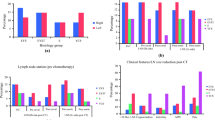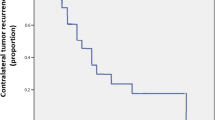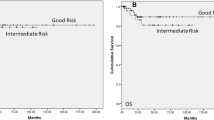Abstract
Purpose
The aim of the study is to determine the association between multifocality and the pathological features of testicular germ cell tumors and its clinical implication.
Methods
Orchiectomy specimens from 254 consecutive patients with testis cancer between 2003 and 2013 were included. Multifocality was defined as a distinct tumor focus of cluster of malignant cells > 0.5 mm and separable from the main tumor mass. Univariate logistic regression analysis was performed to evaluate the association between multifocality and other pathological features. Multivariate logistic regression analyses were carried out to identify potential predictive factors of multifocality for clinical stages II–III and the pathological stage ≥ pT2.
Results
Median patient age was 33 years (range 19–70). Multifocality was identified in 58 (22.83 %) orchiectomy specimens. Subjects with multifocality had larger primary tumor lesions (3.7 vs. 3.0 cm; p < 0.05). No association was found between histology and multifocality (p = 0.95). On univariate logistic regression analysis, multifocality was not significantly associated with all pathological features. On multivariate logistic regression analysis, multifocality was not demonstrated to be an adverse pathological feature of clinical stages II–III (p = 0.23) or pathological stage ≥ pT2 (p = 0.30) when included in a model with tumor size ≥ 4 cm and rete testis invasion in seminoma tumor and neither of clinical stages II–III (p = 0.36) or pathological stage ≥ pT2 (p = 0.20) when included in a model with lymphovascular invasion and percentage of embrional cancer ≥ 50 % in non-seminoma ones.
Conclusion
Multifocality should not be considered an adverse pathological feature in patients with testis cancer, independently to histological subtypes.
Similar content being viewed by others
References
Engholm G, Ferlay J, Christensen N, Bray F, Gjerstorff ML, Klint A, Kotlum JE, Olafsdottir E, Pukkala E, Storm HH (2010) NORDCAN—a Nordic tool for cancer information, planning, quality control and research. Acta Oncol 49(5):725–736. doi:10.3109/02841861003782017
La Vecchia C, Bosetti C, Lucchini F, Bertuccio P, Negri E, Boyle P, Levi F (2010) Cancer mortality in Europe, 2000–2004, and an overview of trends since 1975. Ann Oncol 21(6):1323–1360. doi:10.1093/annonc/mdp530
Jemal A, Siegel R, Ward E, Hao Y, Xu J, Thun MJ (2009) Cancer statistics, 2009. CA Cancer J Clin 59(4):225–249. doi:10.3322/caac.20006
Albers P, Albrecht W, Algaba F, Bokemeyer C, Cohn-Cedermark G, Fizazi K, Horwich A, Laguna MP (2011) EAU guidelines on testicular cancer: 2011 update. Eur Urol 60(2):304–319. doi:10.1016/j.eururo.2011.05.038
Albers P, Siener R, Kliesch S, Weissbach L, Krege S, Sparwasser C, Schulze H, Heidenreich A, de Riese W, Loy V, Bierhoff E, Wittekind C, Fimmers R, Hartmann M (2003) Risk factors for relapse in clinical stage I nonseminomatous testicular germ cell tumors: results of the German Testicular Cancer Study Group Trial. J Clin Oncol 21(8):1505–1512. doi:10.1200/JCO.2003.07.169
Bokemeyer C, Kuczyk MA, Serth J, Hartmann JT, Schmoll HJ, Jonas U, Kanz L (1996) Treatment of clinical stage I testicular cancer and a possible role for new biological prognostic parameters. J Cancer Res Clin Oncol 122(10):575–584
Sobin LH, Gospodarowicz MK, Wittekind C (2009) TNM classification of malignant tumors. UICC International Union Against Cancer, 7th edn. Blackwell, Oxford, pp 249–254
Aparicio J, Germa JR, Garcia del Muro X, Maroto P, Arranz JA, Saenz A, Barnadas A, Dorca J, Guma J, Olmos D, Bastus R, Carles J, Almenar D, Sanchez M, Paz-Ares L, Satrustegui JJ, Mellado B, Balil A, Lopez-Brea M, Sanchez A (2005) Risk-adapted management for patients with clinical stage I seminoma: the Second Spanish Germ Cell Cancer Cooperative Group study. J Clin Oncol 23(34):8717–8723. doi:10.1200/JCO.2005.01.9810
Warde P, Specht L, Horwich A, Oliver T, Panzarella T, Gospodarowicz M, von der Maase H (2002) Prognostic factors for relapse in stage I seminoma managed by surveillance: a pooled analysis. J Clin Oncol 20(22):4448–4452
Valdevenito JP, Gallegos I, Fernandez C, Acevedo C, Palma R (2007) Correlation between primary tumor pathologic features and presence of clinical metastasis at diagnosis of testicular seminoma. Urology 70(4):777–780. doi:10.1016/j.urology.2007.05.020
Ehrlich Y, Konichezky M, Yossepowitch O, Baniel J (2009) Multifocality in testicular germ cell tumors. J Urol 181(3):1114–1119. doi:10.1016/j.juro.2008.11.025 (discussion 1119–1120)
Hargreave TB (1986) Carcinoma in situ of the testis. Br Med J (Clin Res Ed) 293(6559):1389–1390
Skakkebaek NE (1972) Possible carcinoma-in situ of the testis. Lancet 2(7776):516–517
Russo GI, Cimino S, Castelli T, Favilla V, Urzi D, Veroux M, Madonia M, Morgia G (2013) Percentage of cancer involvement in positive cores can predict unfavorable disease in men with low-risk prostate cancer but eligible for the prostate cancer international: active surveillance criteria. Urol Oncol. doi:10.1016/j.urolonc.2013.07.004
Schmoll HJ, Souchon R, Krege S, Albers P, Beyer J, Kollmannsberger C, Fossa SD, Skakkebaek NE, de Wit R, Fizazi K, Droz JP, Pizzocaro G, Daugaard G, de Mulder PH, Horwich A, Oliver T, Huddart R, Rosti G, Paz Ares L, Pont O, Hartmann JT, Aass N, Algaba F, Bamberg M, Bodrogi I, Bokemeyer C, Classen J, Clemm S, Culine S, de Wit M, Derigs HG, Dieckmann KP, Flasshove M, Garcia del Muro X, Gerl A, Germa-Lluch JR, Hartmann M, Heidenreich A, Hoeltl W, Joffe J, Jones W, Kaiser G, Klepp O, Kliesch S, Kisbenedek L, Koehrmann KU, Kuczyk M, Laguna MP, Leiva O, Loy V, Mason MD, Mead GM, Mueller RP, Nicolai N, Oosterhof GO, Pottek T, Rick O, Schmidberger H, Sedlmayer F, Siegert W, Studer U, Tjulandin S, von der Maase H, Walz P, Weinknecht S, Weissbach L, Winter E, Wittekind C (2004) European consensus on diagnosis and treatment of germ cell cancer: a report of the European Germ Cell Cancer Consensus Group (EGCCCG). Ann Oncol 15(9):1377–1399. doi:10.1093/annonc/mdh301
Conflict interest
Each author discloses that no competing financial interests exist.
Author information
Authors and Affiliations
Corresponding author
Rights and permissions
About this article
Cite this article
Favilla, V., Russo, G.I., Spitaleri, F. et al. Multifocality in testicular germ cell tumor (TGCT): what is the significance of this finding?. Int Urol Nephrol 46, 1131–1135 (2014). https://doi.org/10.1007/s11255-013-0617-6
Received:
Accepted:
Published:
Issue Date:
DOI: https://doi.org/10.1007/s11255-013-0617-6




